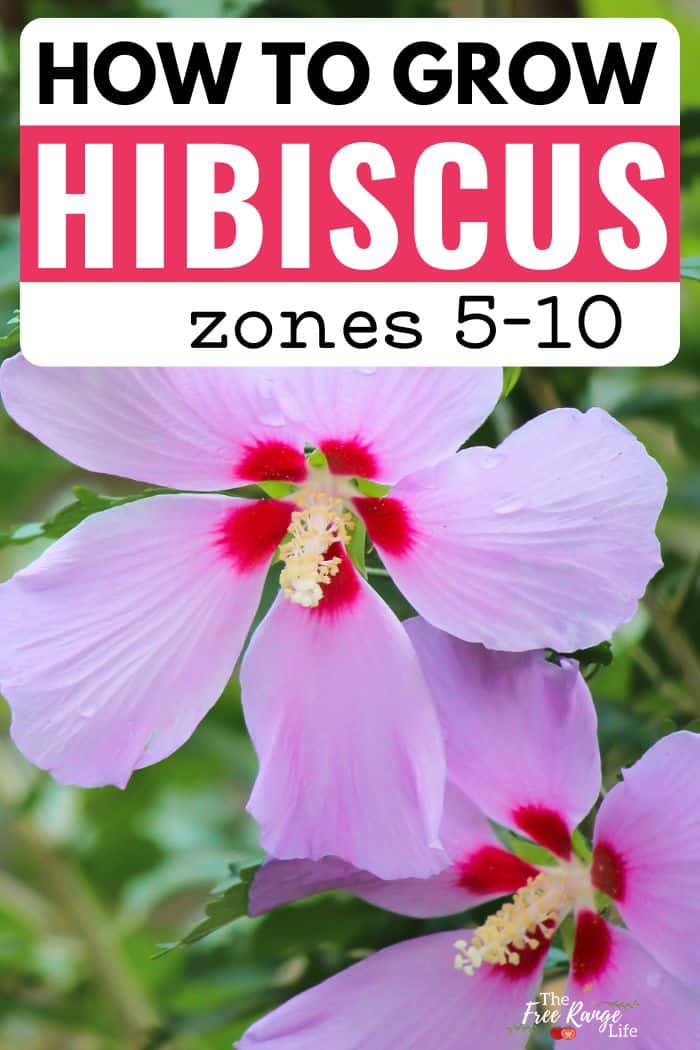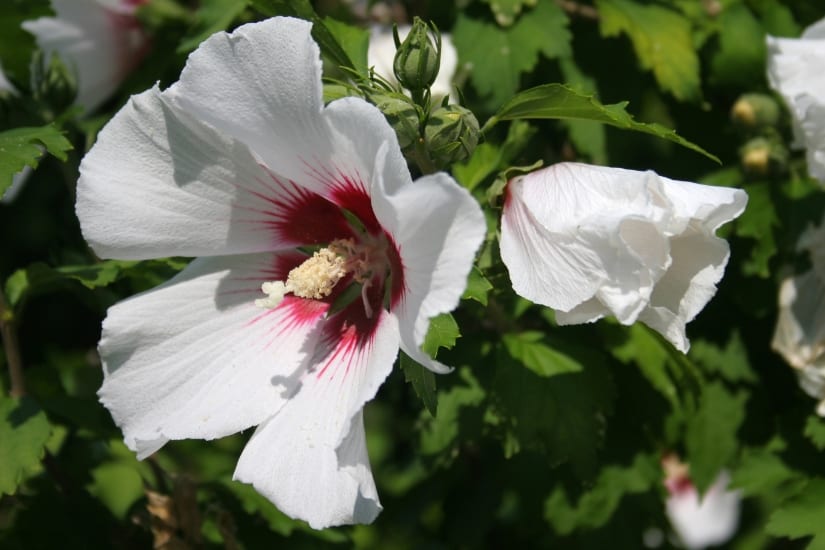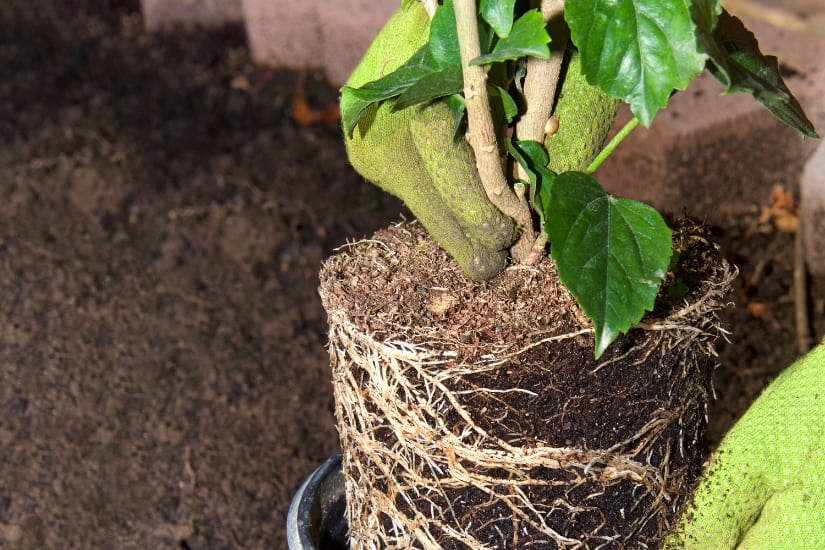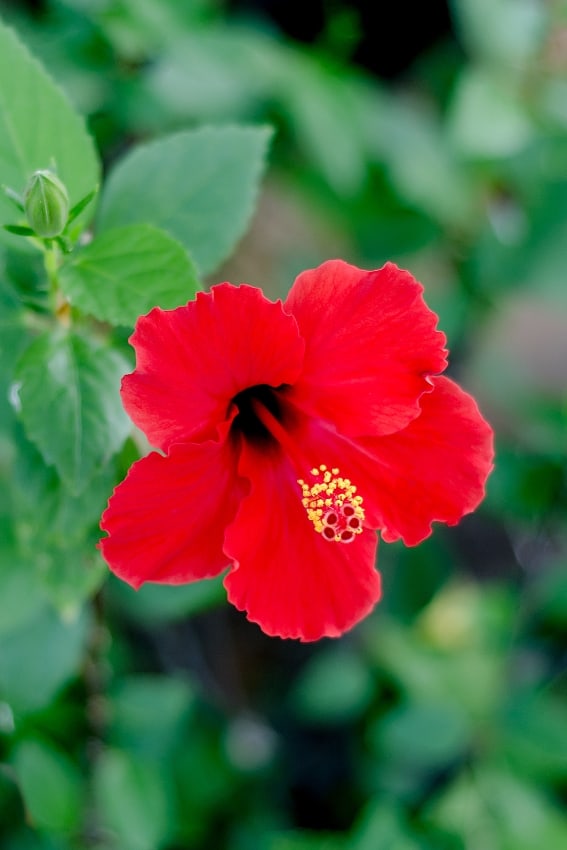Do you want to bring tropical colors to your garden? Learn how to grow hibiscus for an amazing show of huge flowers!
If you’re looking for a tropical plant that will add some color to your garden, hibiscus is a great option.
This site contains affiliate links. If you make a purchase using one of these links, I may earn a commission. Please see my disclosure page for more information about cookies collected and our privacy policy.
With their huge, dinner-plate sized flowers, perennial hibiscus plants add a tropical look to any garden.
They are also wonderful for attracting butterflies and hummingbirds to your yard and garden!
In this article, we’ll give you some tips on how to grow hibiscus successfully. With a little care, you’ll be able to enjoy these beautiful flowers all summer long!
What is Hibiscus?
Hibiscus is a flowering plant that belongs to the mallow family.
There are many different types of hibiscus including annual hibiscus and hardy hibiscus.
This article focuses on the perennial hardy hibiscus.
These flowers are often seen in warm climates but can also thrive in non-tropical locations- USDA zones 5-10.
Perennial hibiscus can grow as tall as 8 ft and produces large, round, flowers similar to hollyhocks.
Hibiscus Varieties to Try
Adding variety to your outdoor garden can make all the difference, and if you’re looking to add more color, try one of these varieties of hibiscus:
- Scarlet Swamp Hibiscus- 10-12 inch wide flowers with 5 petals. 3-7 foot tall plants.
- Lady Baltimore- large pink, dark-eyed flowers, one of the earliest for flowering
- Cherry Brandy- Large red flowers measuring 8-10 inches wide
- Midnight Marvel- Deep scarlet flower, 4ft tall and wide plants.
- Disco Belle Pink- Dwarf varieties growing 2ft tall, 8 inch wide showy flowers.
How to Grow Hibiscus in Your Yard or Garden
When and Where to Plant Hibiscus
Growing hibiscus is an excellent way to bring vivid colors and exotic blooms to any yard or garden. To ensure success, it’s important to determine the ideal location for your hibiscus plants.
Hibiscus plants can be purchased from local nurseries or online garden centers. You can also start new plants from cuttings of mature plants.
Ideal times for planting hibiscus are when both soil temperatures and air temperatures rise above sixty-five degrees Fahrenheit. So don’t plant until after your last spring frost date.
If you’re planting in containers, select a pot large enough to accommodate mature roots, with several drainage holes at the bottom.
When planting outside in the garden, make sure you choose a spot with full sunshine exposure. Hibiscus need at least 6 hours of full sun, but will do better with at least 8 hours.
Less sun equals less flowers- so plant them in the sunniest place you have. The plants might sprawl more and have too-tall stems when they don’t get enough sunlight too.
Hibiscus isn’t too picky about their location. They can thrive in many soil types. You should dig in plenty of organic matter and compost before planting.
While they can handle some wetness, they don’t like to sit in puddles, so make sure your soil has fairly good drainage.
How to Plant Hibiscus
Planting your own hibiscus can be a rewarding experience and relatively easy to do.
While you can start them from seed, you’ll get quicker results if you buy young plants from a nursery.
Use a shovel to dig holes about twice the width and depth of your po.
Plant the potted hibiscus so that the stem is at the ground level.
Once planted, give your hibiscus plant a deep watering to give it a great start.
Water frequently that first week to ensure the roots recover from transplanting.
How to Care for Hibiscus
Caring for hibiscus plants is not a difficult task, but there are some important steps to follow in order to ensure your plants stay healthy and vibrant!
Hibiscus needs lots of water, especially when they are young and just getting established. Water at least 2-3 times a week the first couple months.
Adding mulch around the plant can help conserve moisture- as well as protect the roots in the winter.
Once the plant flowers, remove any spent flower to encourage more blooms.
Perennial hibiscus will die back each year and you can cut the stems to the ground when this happens.
Apply compost or fertilizer in each spring to encourage new growth and blooms.
Troubleshooting: Hibiscus Pests & Disease
Though hibiscus is easy to grow, it does have a few pests that can cause problems.
Common hibiscus pests include:
- Aphids
- Japanese Beetles
- Scales
- Mealybugs
- Whiteflies
Soap and water or insecticidal soap can help with many of these pests. Or you can use a Neem Oil spray.
Encouraging beneficial insects, such as ladybugs, can help control many of these pests as well.
Diseases are usually caused by fungi that infect the stems and leaves
To help prevent pests and diseases in the first place make sure to give your hibiscus adequate space for air circulation, avoid overwatering, and be sure to clean up any plant debris that could contaminate the soil.
Growing Hibiscus FAQ
Is hibiscus a perennial?
Yes, hardy hibiscus is a perennial in zone 5-10.
Does hibiscus need to be pruned?
Yes, hibiscus benefits from being pruned in the winter. Flowers bloom on new growth, so old growth can be pruned out each year.
Can you grow hibiscus from seed?
While you can grow hibiscus from seed, it is more difficult than purchasing seedlings or propagating from a cutting.
Are hibiscus easy to grow?
They are a very hardy and forgiving plant, making them very easy to grow in most locations.
Hibiscus are lovely, tropical plants that can brighten up any space. With a little care and attention, they can thrive indoors or outdoors. We hope this guide has been helpful in showing you how to grow hibiscus successfully.
Want to learn more about growing your own flowers, herbs, and vegetables? Check out these articles:
How to Grow Calendula from Seed
How to Save Zinnia Seeds for Next Year






